Introducing databaseEZ: The serverwide Lotus Notes database property manager
These are exciting times here at Ytria—we’ve recently released a new tool for Domino administrators. It’s called databaseEZ and it lets you see and manage global database properties for a Domino server. We’re going to use this post as a guided tour, so to speak, of its most basic features.
[Edit: It has now been over year since databaseEZ was released and it’s already earned a reputations as a must-have admin tool. Check out this Webcast to see a more in-depth overview, including features that were added after this post was written.]
The databaseEZ main screen
The image below shows the overall look of databaseEZ (it should feel quite familiar to aclEZ and agentEZ users). The title bar tells us we’re looking at a Domino server named “Demo2″; databases on this server are listed in the panel on the left-hand side. The selected databases and their properties are shown in the main grid pane (you can customize the properties shown in this grid with the Grid Data Composition panel). Lastly, the bottom of the screen shows the Output panel (for displaying errors and logs) and the Property Analyzer (for scanning servers for particular properties and issues—more on this later) panel.
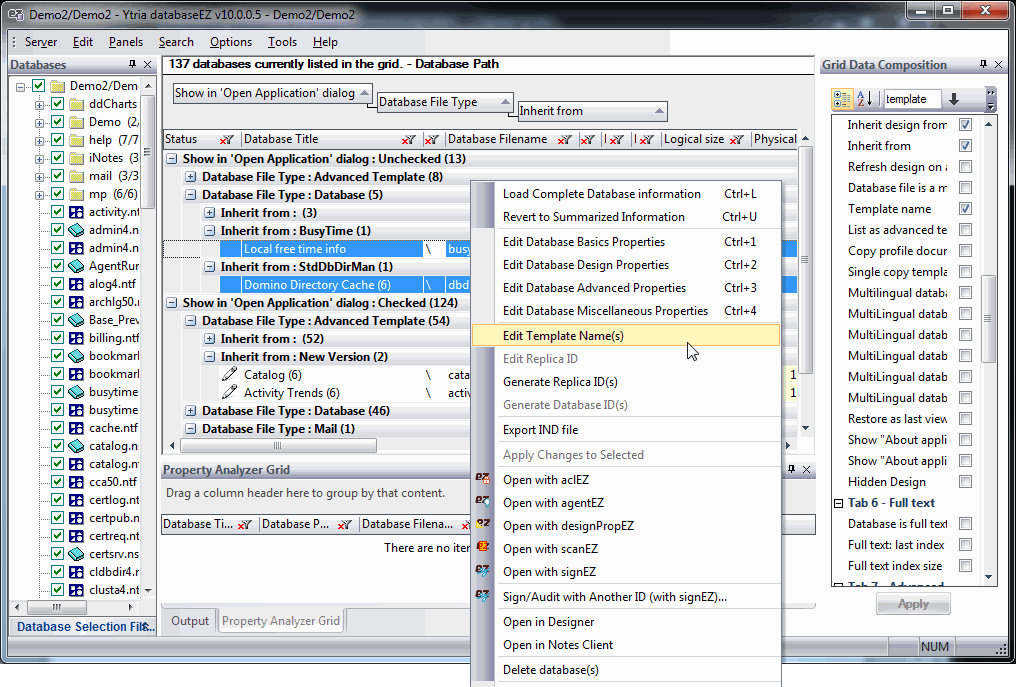
The databaseEZ main screen showing Lotus Notes databases grouped by multiple properties
The image above also shows how multiple levels of column header grouping can help you find databases with particular combinations of properties set (in the example, we’re looking at the ‘Inherit from’ setting for databases that aren’t set to appear in the ‘Open Application’ dialog). In addition, you can see the many right-click contextual menu options available.
The screen below shows another scenario where databases are grouped by their full-text index status. Another feature that’s not shown here but often very useful is the column header filter capabilities; you can click the ‘funnel’ icon on any column header to filter by text, regular express or value.
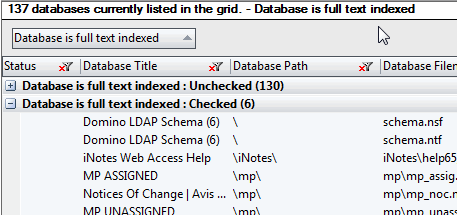
Grouping Lotus Notes databases by whether-or-not they have full-text search enabled
Beyond the advantages that come from its grid interface, databaseEZ also excels in terms of thoroughness. The program can show nearly 100 different NSF properties in its grid (to put this in context, you can see 21 properties in the Domino Administrator).
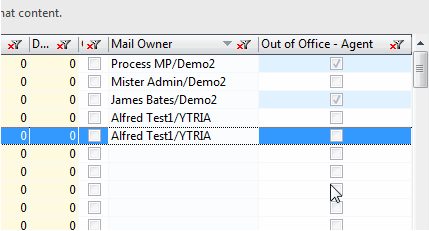
databaseEZ also shows properties that are difficult to retrieve elsewhere like mailfile owners and out of office agent status
Summarized data: the faster, better way to retrieve properties
One of the nicest things about databaseEZ is that it uses summarized data to gather most global NSF properties. This offers two significant benefits:
It loads the database properties almost instantly
It will show you these summarized properties even for databases to which you have no access
The image below shows how properties gathered using summarized data are highlighted in yellow in databaseEZ’s grid. The remaining, non-summarized properties are shown when you click Ctrl+L or Edit>Load Complete Database Information.
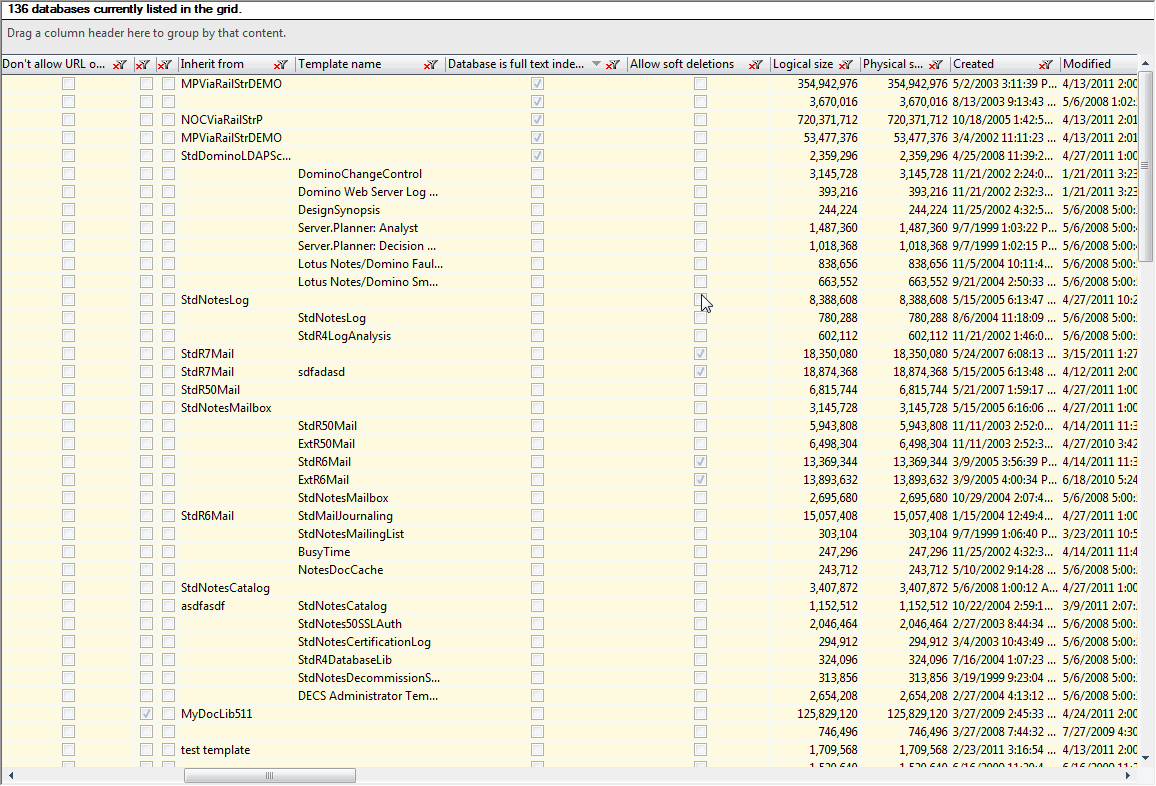
Mass-editing Global NSF Properties
Databases selected in the grid can be edited en-masse using the Edit menu or right-click menu options. As the image below shows, databaseEZ offers an advantage over the Administrator client in that it provides visual feedback on the current status of the selected databases properties before you edit them.
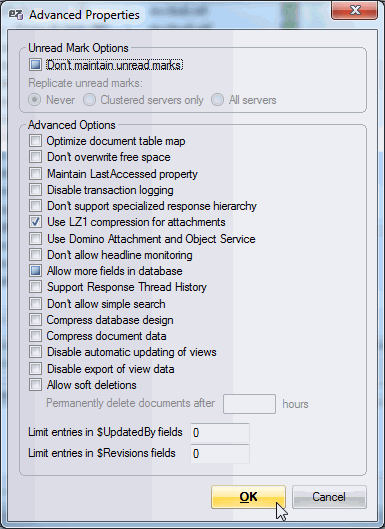
Not only can you mass-edit database properties, you can also see their current status (e.g. the checkbox indicates that LZ1 compression is currently enabled in all selected files)
Check the image below for an overview of the database property editing (and mass-editing) dialogs.
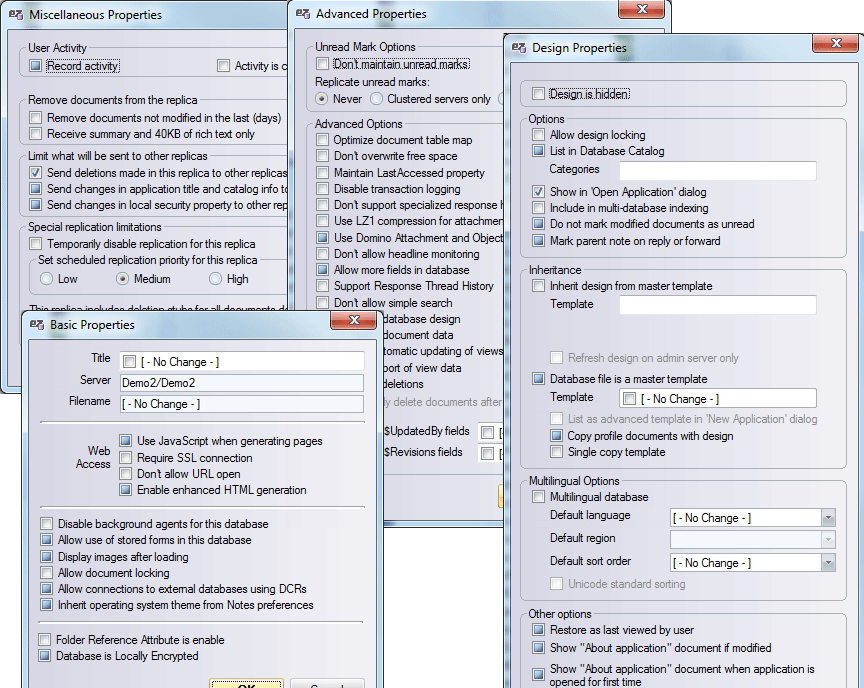
databaseEZ mass-editing options for Lotus Notes properties
Scan Domino servers for property issues and more…
The Serverwide Property Analyzer tool in databaseEZ offers a novel way to find databases that have particular issues (e.g. multiple NSF files sharing the same Replica ID) or characteristics (e.g. their document data hasn’t changed within a given period). Please note that the settings for this dialog are ‘sticky’, so you can close and re-launch databaseEZ and run the same Property Analyzer scan.
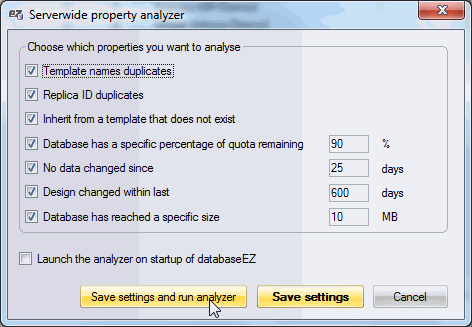
The Property Analyzer scans servers for databases with issues and particular properties
The results of a Property Analyzer scan are displayed in a grid at the bottom of databaseEZ’s screen. You can right-click any databases in this panel to select them in the main grid.
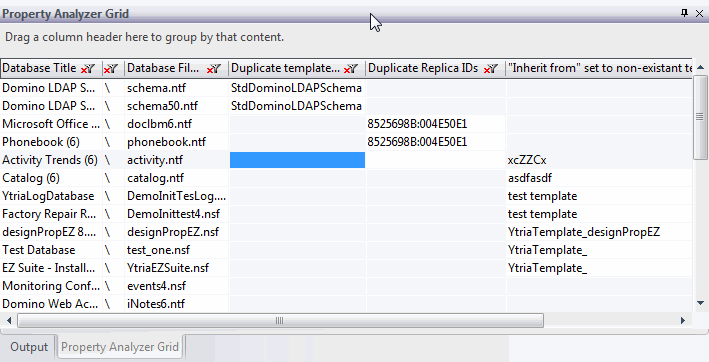
The Property Analyzer grid highlights databases with issues or ‘exceptional’ properties
Generate new Replica IDs for many databases at once
Another handy feature in databaseEZ is its ability to assign new Replica IDs to any number of databases selected in the grid. When working locally, you also have the ability to generate Database IDs in a similar manner.
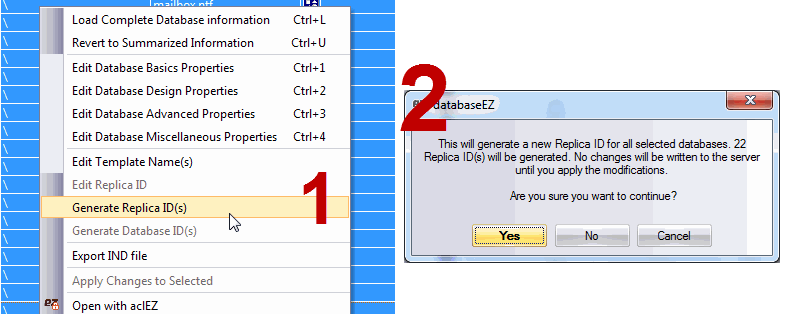
Generating new Lotus Notes Replica IDs en-masse
Customize the databaseEZ interface
As agentEZ users already know, the Grid Data Composition panel lets you choose which columns to appear in the main grid. Since databaseEZ will let you manage so many NSF properties, the grid can get a little overwhelming if you show everything. This panel lets search* for properties and also allows you to save and load preferences. (Tip: Power users will probably want to create multiple sets of preferences that jibe with their various administration/analysis routines).
*Astute agentEZ users might be wondering, “why doesn’t its Grid Data Composition panel have a search?” Well, it will, in the very next update–stay tuned.
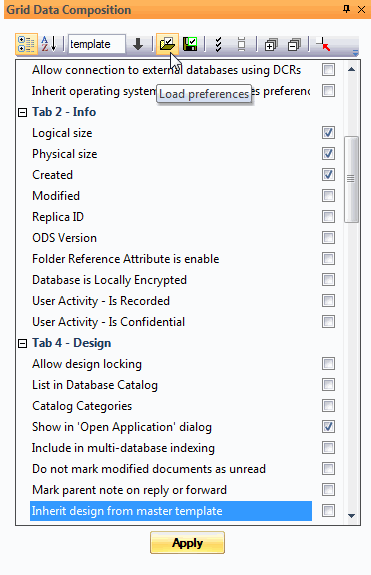
Thanks for coming along for this brief tour of databaseEZ. Future Ytria Tech Lab articles will offer tips and show practical applications for this tool. In the meantime, if you have any questions or comments be sure to get in touch.
Appendix A: Summarized NSF properties
Explore this list to learn which Lotus Notes database properties databaseEZ retrieves using summarized data:
Summarized NSF properties
Allow Design Locking
Allow document locking
Allow more fields in database
Allow soft deletions
Catalog Categories
Compress database design
Compress document data
Created
Database file is a master template
Database ID
Database is full text indexed
Database is the target of a link
Disable automatic updating of views
Disable transaction logging
Do not mark modified documents as unread
Don’t allow headline monitoring
Don’t allow simple search
Don’t Allow URL Open
Disable background agents for this database
Don’t maintain unread marks
Don’t overwrite free space
Don’t support specialized response hierarchy
Folder Reference Attribute is Enabled
Hidden Design
Include in Multi-Database Indexing
Inherit design from master template
Inherit from…
Is database Link
Is Logged
Last Data Modified
Last fixup
Last Non-Data Modified
List as Advanced Template in ‘New Application’ dialog
List in Database Catalog
Logical Path
Logical Size
Maintain LastAccessed property
Max Size
Modified
Multilingual database
Multilingual database: At least 1 default language is selected
ODS Version
Optimize document table map
Out of Office – Service
Physical Path
Physical Size
Quota Limit
Quota Warning
Send deletions made in this replica to other replicas
Refresh design on admin server only
Remove Documents not modified in the last (days)
Replica ID
Replicate document abstract only
Replicate unread marks when…
Replicate using schedule for priority applications
Requires SSL Connection
Schedule replication priority for this replica
Show in ‘Open Application’ dialog
Single Copy Template
Soft deletions made in this replica to other replicas
Space Used
Support response Thread History
Template name
Temporarily disable replication from this replica
Use DAOS
Use Javascript when generating pages
Use LZ1 compression for attachments
Appendix B: All supported NSF properties
Explore the categories below to see all the NSF properties you can manage in databaseEZ:
Database basics
Database is the target of a link
Use Javascript when generating pages
Requires SSL Connection
Don’t Allow URL Open
Enable enhanced HTML generation
Enable Domino REST API operations
Disable background agents for this database
Allow use of stored form in this database
Display images after loading
Allow document locking
Allow connection to external databases using DCRs
Inherit operating system theme from Notes preferences
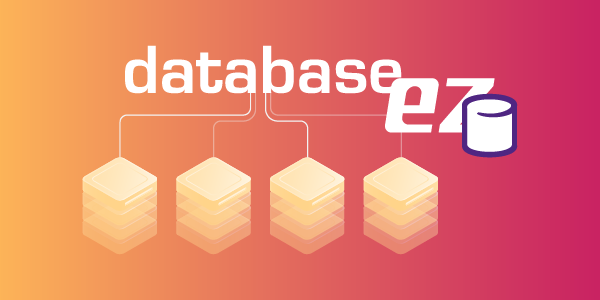
Hi,
In Database EZ, how to open few servers at one time, due to we wish to analysis the same database at multiple servers.
Many thanks in advance for your reply.
Regards, Terry.
Hi Terry,
With databaseEZ, you can manage your global database properties on one server at a time.
In order to analyze the same database on multiple servers at once, you would use Ytria’s replicationEZ. It allows you to load databases across multiple servers so you can analyze and troubleshoot your replication with a vast array of functions to help with everything from charting topology to analyzing your replicas, clusters, logs, conflicts, replication history, and much more.
The Main Grid will display the same properties available in the Database Properties Dialogue in Notes. And below the Main Grid, the Selected Databases panel displays properties that do NOT replicate specific to each database.
You can see a complete list of the properties available in replicationEZ on this page: https://docs.ytria.com/replicationEZ/the-grid-data-composition-panel
Then select your databases from this panel and modify their properties in multiple instances of databaseEZ. Just highlight the databases and servers in replicationEZ and right-click to open. This will open multiple instances of databaseEZ on different servers.
You can watch a quick video of this tool here: https://www.youtube.com/watch?v=7f92Y-thEco
Thanks for your question!